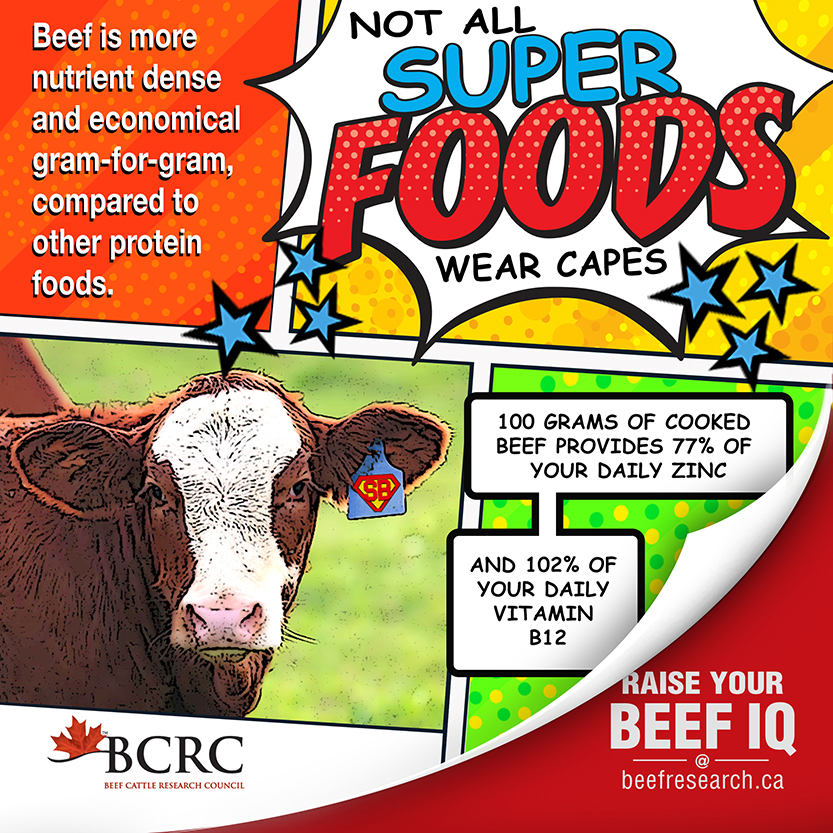Beef is a complete protein, and a valuable source of key nutrients like iron, zinc, and vitamin B12. Essential at every stage of life, key nutrients are often not provided in sufficient amounts in plant-based foods. Beef is a nutritious, convenient and affordable way for Canadians to meet their nutritional needs, particularly for people at risk of iron and zinc deficiencies, such as women and infants. In fact, gram-for-gram, beef is more nutrient dense and more economical than many other protein foods.
For the latest information on beef nutrition in Canada, please visit www.thinkbeef.ca/nutrition/
| Key Points |
|---|
| Beef contains several essential nutrients including protein, iron, zinc, selenium, riboflavin, niacin, vitamin B6, vitamin B12, phosphorus, pantothenate, magnesium, and potassium. |
| Many Canadians are nutritionally deficient. Vitamin B12 and zinc intake are inadequate in 10-35% of men and women, and iron is inadequate for 16-19% of women aged 19 to 50. In Canadian men aged 70 and older, 41% are deficient in zinc.9 |
| Beef has a synergistic benefit (i.e., the Meat Factor). Adding beef to a meal will increase the absorption of iron from other foods like plant-based proteins and vegetable.8 |
| Iron from beef is “heme” iron, meaning it is bioavailable and more easily absorbed by the body than “non-heme” iron from plant-based sources such as spinach or legumes. |
| Protein found in beef and other meats are referred to as “complete” proteins because they contain appropriate levels of all the essential amino acids required for human nutrition. |
| More than half of the fat in beef is unsaturated and most of the unsaturated fat is oleic acid, the same type of “healthy” fat found in olive oil. |
| Canadians do not eat too much red meat. In fact, they may not eat enough. Recent dietary evidence showed that 48% of Canadian women ages 31-50, 69% of women aged 70 years and older, and 56% of adolescent males do not eat the recommended amount (grams or servings) of meat and protein alternatives.2 |
Canada’s Beef Consumption
Canadian diets are changing and not necessarily for the better. According to recent data, red meat intakes have declined over time. Canadians are eating less red meat than ever before, while at the same time, consumption of ultra-processed foods has steadily increased. The trend data suggests that Canadians have swapped foundational foods like beef, eggs and milk for energy-dense fast-food items.
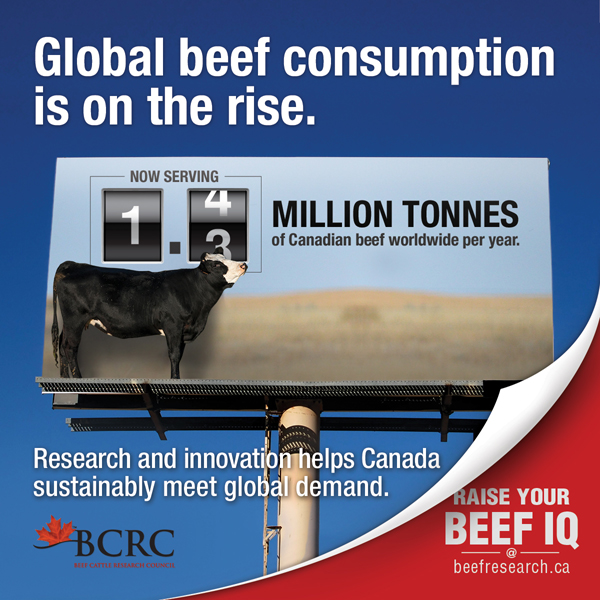
Health Canada’s Evidence Review for Dietary Guidance demonstrates that 48% of Canadian women ages 31-50, 69% of women aged 70 years and older, and 56% of adolescent males are eating less than the recommended amount of meat and alternatives.2 The same report noted that some Canadian demographics, particularly women and older adults, have inadequate intake of iron, zinc, and vitamin B12. Iron and zinc are available in red meat in the form that the body can most easily absorb and vitamin B12 is found only in foods of animal origin.
Nutritional guidelines are largely based on whole ingredients and home-cooked foods. However, today, more foods than ever are processed, packaged, and eaten with minimal home-preparation. On average, Canadians are consuming nearly half of their daily calories from ultra-processed foods,3 and only five per cent of their calories are consumed from nutrient-rich red meat.4
Eating Beef and Your Health
The effect of diet on health is widely studied around the world and there are plenty of high-profile studies with conflicting results. Most studies do agree, however, that ultra-processed foods of all types can increase health risks. The nutritional benefits of a balanced, diverse diet that includes whole foods such as protein foods like beef, whole vegetables and fruits and whole grains, is greater than the sum of their parts.
In a recent large-scale analysis of nutritional studies that assessed 54,000 individuals, experts determined that there was not a significant association between meat consumption and heart disease, cancer or diabetes.5 The expert panel determined that there was little or no health benefit to reducing red meat consumption and that most people can continue eating red meat at current average intakes.
In a highly publicized assessment in 2015, the International Agency for Research on Cancer (IARC) classified fresh red meat as “probably carcinogenic” to humans. Since that controversial episode, both the World Health Organization and Health Canada have identified that red meat is a valuable source of nutrients and that a balance can be maintained between the nutritional advantages of consumption and potential disadvantages.6 IARC methodology assesses the potential hazard which varies according to several factors that don’t necessarily correlate to an increased risk. For example, IARC has classified ultraviolet light from sunshine as a carcinogenic hazard, however the risk that it poses to individuals will depend on amount and type of exposure, genetics, age and more.
Whole foods high in protein, like beef, can play a role in an overall wellness strategy. Beef can help people retain muscle mass and stay full for longer at a lower calorie count per nutrient than many other protein foods. Red meats, including beef, can be an important part of a healthy diet to manage diabetes. High protein diets can reduce blood glucose and help improve the metabolic profile.7
Beef as an Important Part of a Balanced Diet
Few foods are as nutrient dense as beef, which is a complete protein food and a valuable source of several essential nutrients like iron, zinc, selenium, riboflavin, niacin, vitamin B6, vitamin B12, phosphorus, pantothenate, magnesium, and potassium. Beef is also a source of other important nutrients such as choline and monounsaturated fats.
Eating beef has a synergistic benefit known as the Meat Factor. This means eating beef along with other vegetables and legumes increases the absorption of iron from these other foods.
Canada’s food guide now focuses on eating habits and creating a “healthy plate” rather than specific serving sizes. A healthy plate consists of food from three main categories, vegetables and fruit, protein foods (including beef), and whole grain foods.
Certain nutrients in beef may be absorbed more readily than nutrients in other foods. For example, iron from beef is in “heme” form (bound to the protein myoglobin which is exclusively found in meat) and more easily absorbed and used by the body than iron from other sources such as spinach, legumes, or eggs. Beef can also have a synergistic benefit8 (i.e., the “Meat Factor”). When beef is added into certain meals, it increases absorption of iron from other foods or ingredients like plant-based proteins and vegetables. For example, adding ground beef to a bean dish allows an individual to absorb 150% more iron than a vegetable-only version. A balanced diet contains both plant- and animal-sourced foods.
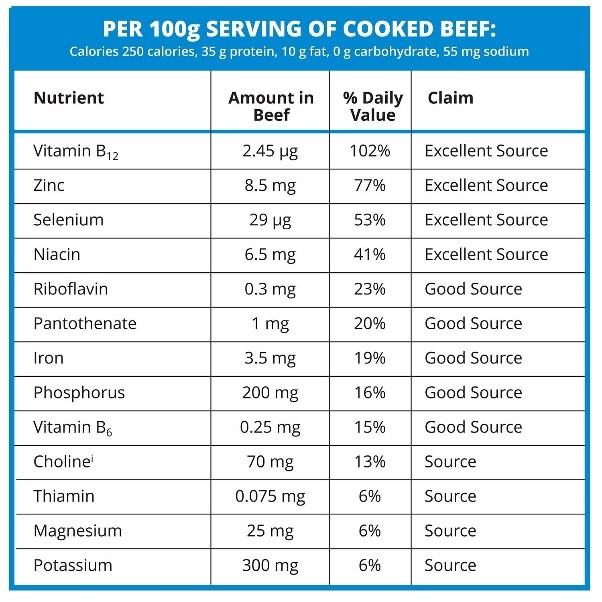
Source data: Health Canada, Canadian Nutrient File, 2015 version. Food Code 6172: beef, composite cuts, steak/roast, lean and fat, cooked.
Nutrient amounts have been rounded according to the rounding rules in the 2016 CFIA labelling regulations. % Daily Values calculated based on Health Canada’s 2016 Nutrition Labelling – Table of Daily Values.
iCholine value obtained from U.S. Department of Agriculture, Agricultural Research Service. FoodData Central, 2019. fdc.nal.usda.gov. Food Code 13361
A 100-gram serving of cooked beef provides 250 calories, 35 grams of protein, and 10 grams of fat (5.2 grams which is healthier monounsaturated fat). A serving of this size also provides 3.5 mg of iron (19% of the daily recommended value), 8.5 mg of zinc (77% of the daily recommended value), and 2.45 micrograms vitamin B12 (102% of the daily recommended value). Fresh beef is also considered a low sodium option.
According to the Canadian Community Health Survey, Canadians only get 5% of their total calories from unprocessed red meat, including beef, whereas Canadians consume more than 48 per cent of their calories from ultra-processed foods, which include items like pop, chips, and baked goods.4 This is a concern because highly processed foods tend to contain fewer nutrients that Canadians actually require, but are often high in sodium, fat, calories, and sugar.
Nutritional deficiencies occur worldwide, including within Canada. For example, Canadian data showed that vitamin B12 and zinc intake are inadequate in 10-35% of men and women, and iron is inadequate for 16-19% of women aged 19 to 50. In Canadian men aged 70 and older, 41% are deficient in zinc.9 Eating beef can be a healthy, affordable, and effective solution to these common Canadian deficiencies.
Protein
Protein is an essential nutrient that people need for strong bones and muscles, enzyme and hormone production, energy, and wound healing and tissue repair. Dietitians recommend that in order to optimize protein usage, an adult weighing 150 pounds should consume between 80 to 110 grams of protein spread evenly over three to four meals per day.10 As people age, incorporating a diet that is higher in protein may be recommended to help offset muscle loss, improve bone health, and provide nutritional density for smaller appetites.
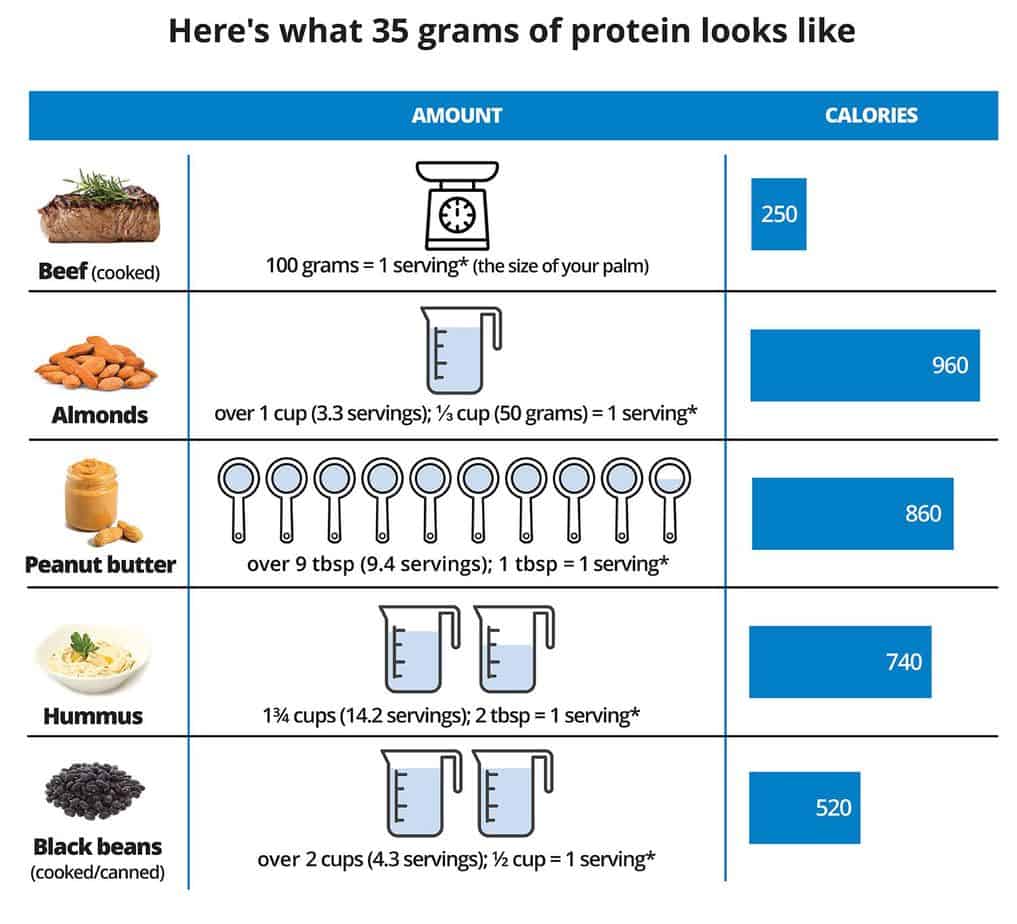
Source data from: Health Canada, Canadian Nutrient File, 2015, Beef 6172, Almonds 2534, Peanut Butter 6289, Hummus 4870, Black Beans 3377. Nutrient amounts rounded as per 2016 CFIA labelling rounding rules. *Table of Reference Amounts for Food
There are nine amino acids that are essential for human health that must come from dietary sources. Protein found in beef and other meats are referred to as “complete” proteins because they contain all 9 essential amino acids that the human body cannot produce and must obtain from the diet. Plant-based proteins (with some exceptions, such as quinoa) lack one or more of these essential amino acids.
Not all protein is created equal. From a nutrient standpoint, beef is mostly comprised of protein and contains no carbohydrates. This makes beef a very efficient source of protein that is bioavailable and ready for the body to metabolize. Plant-based proteins are typically quite high in carbohydrates relative to protein and the protein is less digestible. For example, 100 grams of cooked beef will provide 35 grams of protein with just 250 calories, whereas it would take more than 9 tablespoons of peanut butter, at 860 calories, to provide the same amount of protein.
Iron
Iron is essential for building red blood cells, transporting oxygen from the lungs to the rest of the body, and helping brain function. There are two types of iron in food, “heme” and “non-heme.” Heme iron is easily absorbed by the body, and found in animal foods, including beef. Eating foods that contain heme iron also improves the body’s ability to absorb non-heme iron from plant-sourced foods.6 This type of dietary synergy is sometimes called the “Meat Factor.”
Beef is one of the best food sources of easy-to-absorb heme-iron, which is why Health Canada recommends beef as a first solid food for babies at 6 months.
Iron deficiency is a concern worldwide, including in Canada, which is why iron is listed on the Nutrition Facts table present on all food labels. Inadequate iron can leave people feeling tired, cold, irritable and pale in appearance. Long-term deficiency can cause anemia, delayed growth and development, pregnancy complications, and metabolic problems. Iron needs are greatest during growth (infancy and teens) and for women during their childbearing years. Fortunately, beef is one of the best natural heme iron-rich foods available.
Babies depend on iron for best brain development and growth, however by 6 months of age, their iron stores run low. Babies require 11 mg of iron per day. Beef contains bioavailable heme-iron, the most digestible form of iron for humans, which is why Health Canada recommends beef as a top choice for a first solid food for babies.11
Fat
Fat is an important nutrient for the body, providing energy, aiding growth and development and enabling the body to absorb vitamins A, D, E, and K (i.e. fat-soluble vitamins). There are three different types of fats that naturally occur in foods: unsaturated, saturated, and trans fats.
Unsaturated fats, such as monounsaturated and polyunsaturated fats are “healthy” fats that are important components of a well-balanced diet. More than half (55%) of the fat in beef is unsaturated. Most of the unsaturated fat in beef is oleic acid, the same type of “healthy” fat found in olive oil.
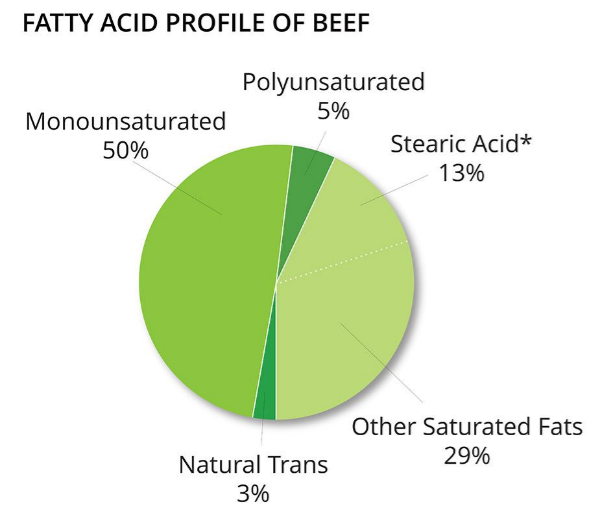
Graph courtesy of Canada Beef.
Source data: Health Canada, Canadian Nutrient File, 2015 version. Food Code 6172: beef, composite cuts, steak/roast, lean and fat, cooked
Beef, like all animal-based foods including dairy and poultry, contains saturated fat. Some plant-based foods, such as palm and coconut oil also contain saturated fats. Approximately 40% of the fat in beef is saturated, including 13% stearic acid. Stearic acid does not contribute to low-density lipoprotein (LDL) cholesterol, the “unhealthy” cholesterol.
About 3% of the fat found in beef is natural trans fat. Trans fat can also be found in other animal-based foods. However, the primary source of trans fat in Canadian diets has been industrially processed foods such as commercially baked goods and vegetable spreads12. A diet too high in industrial trans fats is unhealthy and in 2018, Health Canada banned the use of industrial trans fats from partially hydrogenated oils in food.
For people concerned about managing their general fat intake, beef provides many lean options. Cuts with “round,” “loin,” or “flank” in the name are typically lean. For people choosing ground beef, the amount of fat in ground meats including beef, pork, turkey, or chicken, varies according to labels defined by the Government of Canada. A label of “Extra Lean” indicates there is a maximum of 10% fat in ground beef or ground chicken, for example, while a label of “Lean” indicates a maximum of 17% fat in the ground meat product.
Much of the fat on beef is visible on whole cuts and can be easily trimmed prior to cooking. More than 90% of Canadians report draining their ground beef after cooking, which also reduces the amount of fat consumed. As well, preparing food on a grill can reduce total fat content by approximately one third.
Grass-fed and grain-fed beef are different terms used to describe feeding and finishing practices for beef cattle. One study demonstrated that grass-finished beef was leaner than grain-finished beef by approximately two to four grams per 100 gram serving of trimmed meat. However, in the context of total daily fat consumed, this difference is relatively minor. There were no differences found between cholesterol, iron or zinc levels. Both grain-fed and grass-fed beef provide low levels of omega-3 fatty acids.13 Nutritional differences between grain- and grass-fed are negligible. All beef is a valuable source of nutrients.
Final Thoughts
Balance is the key when it comes to healthy eating. Beef provides high-quality protein without a lot of calories, compared to alternatives. You can’t substitute beef with an equivalent nutrient-dense source of essential nutrients like zinc, iron, and protein, because there is no food just like beef.
- References
-
1. Think Beef, 2024. Red Meat / Beef Consumption in Canada – Backgrounder. Available here.
2. Health Canada, 2015. Evidence Review for Dietary Guidance: Technical Report. Available here.
3. Moubarac, J-C. 2017. Ultra-processed foods in Canada: consumption, impact on diet quality and policy implications. A study commissioned by the Heart & Stroke Foundation of Canada. Available here.
4. Statistics Canada, 2015. Canadian Community Health Survey – Nutrition (CCHS). Available here.
5. Canada Beef, 2020. Evidence review concludes there is no need to reduce red meat consumption for good health. Available here.
6. Canada Beef, 2020. Beef and Chronic Disease. Available here.
7. Think Beef, 2024. Recent Evidence on Red Meat, Protein, and Diabetes. Available here.
8. Engelmann, M., Davidsson, L., Sandstrom, B., Walczyk, T., Hurrell, R., and Michaelsen, K., 1998. The influence of meat on nonheme iron absorption in infants. Pediatric Research, 43(6), 768-773. Available here.
9. Health Canada, 2012. Do Canadian Adults Meet their Nutrient Requirements through Food Intake Alone? Available here
10. Leidy, H. J., Clifton, P. M., Astrup, A., Wycherly, T. P., Westerterp-Plantenga, M. S., Luscombe-Marsh, N. D., Mattes, R. D. 2015. The role of protein in weight loss and maintenance. Am J Clin Nutr. 101(6):1320S-1329S. Available here.
11. Health Canada, 2024. Nutrition for Healthy Term Infants: Recommendations from Six to 24 Months. Available here.
12. Health Canada, 2022. Nutrients (Fats). Available here.
13. Van Elswyk, M.E., McNeill, S.H. 2014. Impact of grass/forage feeding versus grain finishing on beef nutrients and sensory quality: The U.S. experience. Meat Science 96:535–540. Available here.
Feedback
Feedback and questions on the content of this page are welcome. Please e-mail us.
Acknowledgement
Thanks to Karine Barlow (RD) and Joyce Parslow, Canada Beef, and to Dr. Benjamin Bohrer, PhD, from Oklahoma State University, for their contributions of time and expertise during the preparation of this page.
This content was last reviewed January 2025.
